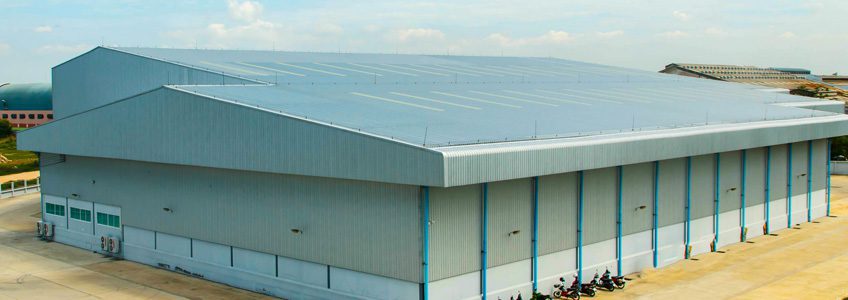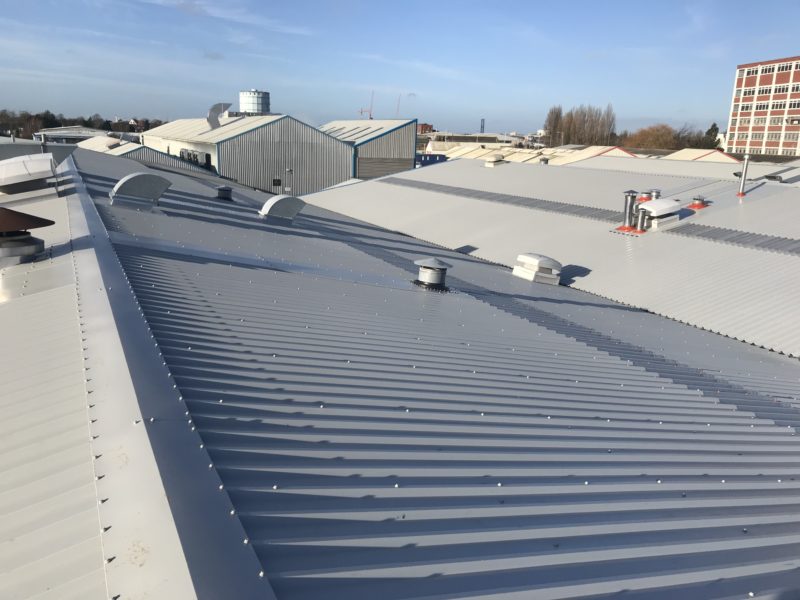Flat vs. Slanted Roof – Which is Right for Your Commercial Building?

To slope or not to slope. The choice may leave you gutterly torn
In the world of commercial building construction, one of the most fundamental decisions is choosing between a flat roof and a sloped roof. Each style has its unique characteristics, advantages, and considerations, which can significantly impact your project's aesthetics, cost, construction timeline, and maintenance schedule.
Today, our team will break down these two styles of roofing and help you make an informed decision for your next design-build project.
Breaking Down Styles of Commercial Roofing
When it comes to long-term structural integrity and upfront costs, there is a lot that differentiates flat and sloped roofs for your commercial building. Let’s take a look from the top down:
Flat roofs are characterized by their nearly level or slight slope. They are a popular choice for modern commercial buildings and provide a clean, minimalist appearance that is suitable for most industries. Additionally, flat roofs maximize space and ease of installation for HVAC units, solar panels, and any other rooftop installation. This “modular” approach to fully utilizing your roof’s footprint makes flat roofs an especially attractive choice for growing businesses and those who want to stay up to date with new and emerging technologies.
However simple they may be in their construction, they can be prone to drainage issues and may require more maintenance to prevent water ponding—something we’ll look at more closely in a minute.
Sloped roofs have a distinct or pronounced slope. They come in various styles, from gable and hip roofs to shed and mansard roofs.Sloped roofs are excellent at shedding water, snow, and debris, making them a practical choice for harsh Canadian winters.
The downside is roofs with higher slopes may not be as viable for placing HVAC and other mechanical equipment on, and access can be more difficult than a flat roof.
How Should I Think About Style in the Building Design?
The style of your building's roof should align with your architectural vision, functionality requirements, and local climate conditions. Here in Alberta, consider factors such as regional aesthetics, energy efficiency, and the future use of the rooftop space. Flat roofs are perfect for a modern, urban look, while sloped roofs may be more fitting for a traditional or rural setting—both of which we are comfortable to design in.
Which Roof Is Easier to Maintain?

Maintenance considerations differ for flat and sloped roofs, and it all comes down to gravity.
Flat roofs are more prone to water pooling and require regular inspections and maintenance to prevent leaks (especially in winter, where ice can be a structural hazard). Sloped roofs have better natural drainage, reducing the risk of water damage. However, they might require more attention during heavy snowfall to prevent ice dam formation and snow-related issues on the roof or for those walking beneath the roof edge.
For a flat roof, you will have year-round access to send employees or contractors on maintenance tasks. With sloped roofs, you will have to consider how to keep your workers balanced and safe as they complete maintenance like these tasks below:
Expected Maintenance for Flat Roofs:
- Bi-Annual Inspections: Flat roofs benefit from frequent inspections, especially after severe weather events. These inspections check for debris buildup, membrane integrity, and potential drainage issues that can lead to standing water.
- Debris Removal: Leaves, dirt, and debris can accumulate on a flat roof, clogging essential drainage systems. Regular inspection is necessary to ensure proper water runoff.
- Sealant and Flashing Inspections: Regular checks of sealant around penetrations and flashing ensure that there are no gaps, cracks, or rusted-out holes that could lead to water infiltration.
- Weatherproofing Maintenance: Flat roofs are constantly exposed to the worst of the elements, and UV rays can degrade roofing materials over time. Periodic re-coating or resealing may be necessary to maintain the roof's structural and aesthetic integrity.
Expected Maintenance for Sloped Roofs:
Gutter Maintenance: Sloped roofs often have gutters to manage water runoff. These should be kept clear of debris to ensure proper drainage and to prevent water damage at ground level.
Roofing Costs and ROI to Consider for Commercial Building
Are you an organization with the manpower to maintain your building yourself, or will you be contracting this work out to others? For professional roof cleaning, you can expect to pay between $17-34 hourly—a cost that adds up given the volume of maintenance needed and the complexity of the structure. Now, if you were to undertake the maintenance schedule yourself, you would have to consider the upfront cost of the tools and specialized equipment. What you have on hand may make or break this specific consideration.
Overall, when considering both maintenance and construction costs, sloped roofs generally offer a better return on investment (ROI) for new commercial buildings. While they may have slightly higher initial construction costs, sloped roofs are often more cost-effective in the long run due to their lower maintenance requirements, better natural drainage, and longer lifespan—especially in regions with heavy snowfall like Alberta.
The choice ultimately depends on your specific needs, climate, and budget considerations. Consulting with design building experts can help you make the best decision for your project's ROI.
